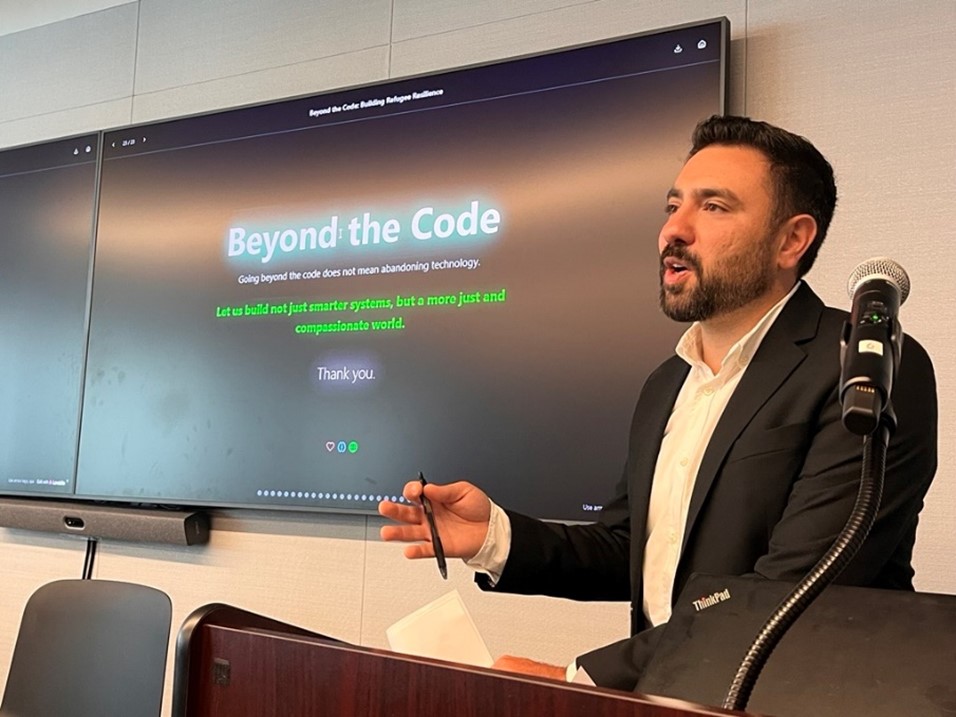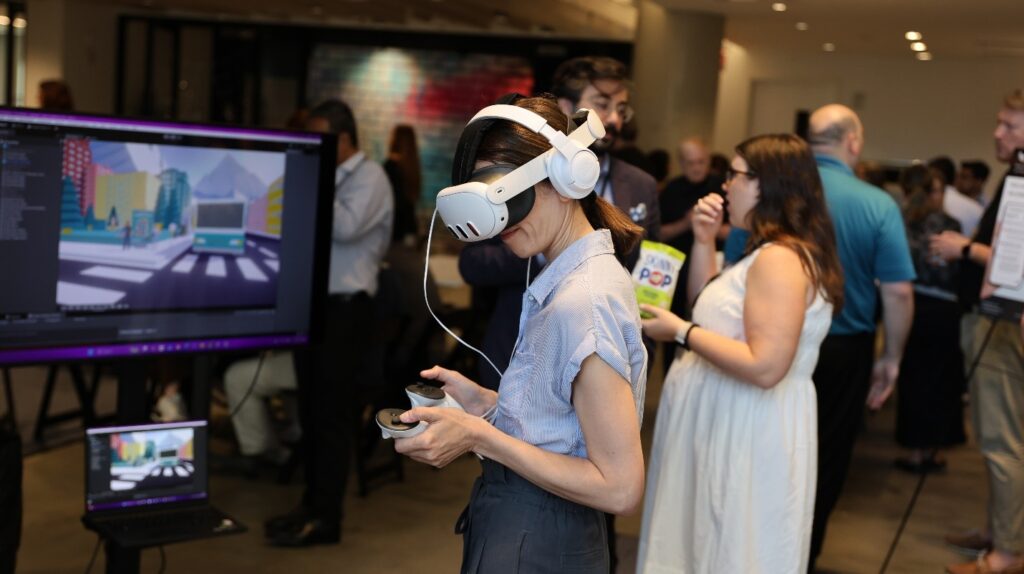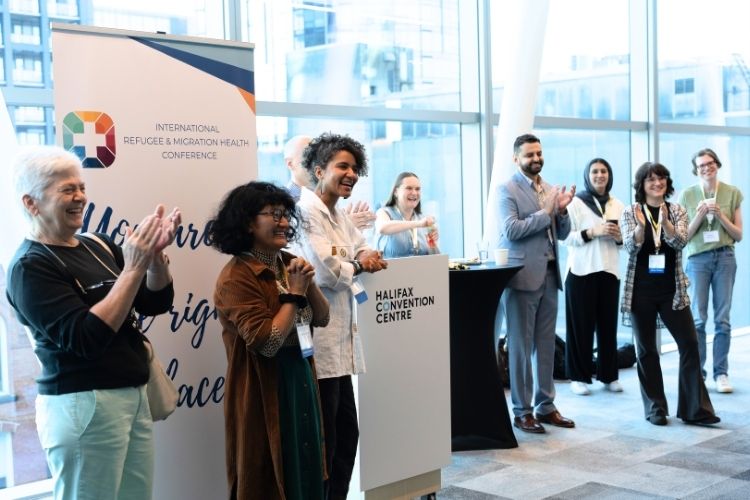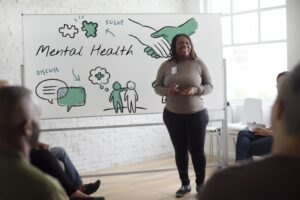About Confluence
Tech conferences are often accused of chasing the next big thing: flashy tools, buzzwords, and speculative breakthroughs. Confluence 2025 took a different path.
Switchboard gathered more than 100 refugee service providers, technologists, government partners, and researchers this past June at Civic Hall in New York City for two days of hands-on conversations about what’s already working and the wise and ethical use of new solutions, including AI. The focus was real-world tools making a difference for newcomers, especially newcomers who live beyond the reach of traditional services.
Participants explored four key principles:
- Technology in resettlement must be ethical and sustainable;
- Virtual services must scale affordably and reach more people;
- Design must happen with, not just for, newcomers; and
- We must improve connectivity so that clients can access trusted, reliable information.
The conversations at Confluence were not only about innovation but also about impact. They were collaborative and grounded in the lived experience of newcomers themselves. The future won’t be delivered by a single platform or program; it will be built by all of us, working together, sharing what works, and refusing to settle for systems that leave anyone behind. Gatherings such as this help us collectively envision a future in which newcomers and service providers are equipped with the tools, technologies, and systems that are already fueling progress across a variety of industries.
Seven Key Takeaways from Confluence 2025
1. Digital skills alone are not enough
Dr. Nathan Walker (AI Ethics Lab, Rutgers) opened the event with a reminder: digital literacy isn’t just technical. His Knowledge, Skills, Attitudes, and Motivation (KSAM) model framed responsible tech use as a whole-person practice. “Without a grounding in motivation,” Walker said, “even the most impressive AI literacy is hollow.”
Competence alone isn’t enough. Purpose is what makes it count. To learn more, see the recording here.
2. Start with the problem, not the product
In a keynote on responsible innovation, Hisham Zawil (UNHCR) described how many organizations are in a rush to apply emerging technologies like AI, so it’s easy to misidentify the real problem. This often leads to “problem flattening” or “problem orphaning,” where we solve adjacent, more tech-friendly issues while the root cause, often outside the scope of algorithms, remains untouched. He referenced a conversation in which a fintech expert proposed a chatbot to solve refugee challenges without understanding the legal and structural barriers behind those challenges.
Tech can’t solve what it doesn’t understand. Good solutions start with good questions and with “recognizing [that] technology and AI [are] never just technical,” said Zawil. They are “‘sociotechnical.’ [Their] impact emerges from the interaction between people, institutions, and systems.”
Find the session recording here.

Hisham Zawil, Private Sector Partnerships Service – Technology Sector Lead with UNHCR, gives the keynote address on day two of the Confluence.
3. Mapping can reveal both resources and gaps
In a session on community resource mapping, panelists from the Tennessee Office for Refugees (TOR), Catholic Charities of Tennessee, and Switchboard showed how mapping initiatives can do more than locate services. They reveal system-level issues like confusing referrals, access barriers, and long wait times. TOR developed their mapping tool during Switchboard’s Co-Creation Certification Course in the spring and discussed how they now include newcomer voices in all aspects of their design process to ensure the product supports its intended outcome, such as helping newcomers apply for benefits.
“If your solution doesn’t work in a moment of stress or disorientation,” said Hameedullah Omari (TOR), “it’s not really a solution.”
Mapping tools help reveal both available resources and pain points, enabling providers to begin coordinating more closely and identifying solutions. To learn about tools addressing resource gaps, see the session recording here.
4. Tech doesn’t have to be flashy to be transformational
Some of the best virtual programs use basic tools, such as WhatsApp, Zoom, or email, to thoughtfully build around real client needs. As Nandini Sridhar (Church World Service) emphasized, what matters most isn’t the tool or platform itself but rather intentional design and integration into programming, including clear communication, flexible timing, language access, and strong follow-through.
“This isn’t about digitizing casework,” Sridhar said. “It’s about reimagining it.” Hybrid models were discussed as a way to combine remote case management with on-the-ground partners that utilize local staff to assist with challenges particular to a location.
See the recording here.
5. If people aren’t coming, the problem may be in how we’re inviting them
Panelists in a session on outreach pushed back on the “hard to reach” label. Jenny Lange (Settle In), Rommel Ojeda (Documented), and April Somboun (Airbel Impact Lab) shared how engagement improves when outreach strategies reflect newcomers’ communication preferences, such as receiving trustworthy information from familiar messengers in their communities or on apps they are already using in their daily lives.
“You can’t paste content onto an unfamiliar channel and call it access,” said Somboun.
Good outreach starts with listening. Learn more by viewing the recording here.
6. AI can extend trust, but it can’t create it
AI tools like the IRC’s ALMA chatbot are helping clients access information and take action without waiting for a staff member to be available. But as Mala Kumar (Humane Intelligence) noted, AI only works when it supports, not replaces, human relationships.
“AI doesn’t fix broken trust,” she said. “It should extend what’s already working, not mask what’s not.”
When used wisely, AI can free up human capacity, but it can’t be a substitute for care. View the session recording here.
7. Learning happens through doing, so include play!
The Technology Playground at the Confluence reminded us that discovery arises through interaction. From virtual reality storytelling to AI interpretation tools, hands-on demos via workshops sparked imagination, surfacing new possibilities and practical insights through play. To design a better resettlement future, we don’t just need ideas; we need to try, test, and experience technology in context.

A Confluence guest uses a virtual reality headset in the Technology Playground.
Looking Ahead
Technology is only as powerful as the intention behind it, and its potential lies in creating deeper connection, expanding access, and restoring agency. Confluence 2025 was a reminder that meaningful and sustainable use of technology in resettlement won’t come from chasing trends. Solutions will come from collectively asking: What do clients actually need? What’s already working? And what’s worth building next?
Learn More
Resources for Clients and Communities
- Settle In Hub ― Multilingual newcomer info center
- Switchboard Community Support Line ― National phone line for referrals to local community services
- Documented.Info ― Support and trusted information for New York newcomer communities
SMS & Mapping Tools
- TextIt ― No-code SMS builder
- Flow Amigo ― Offline mapping + SMS messaging
Ethics
- Switchboard AI Evaluation Tool ― Self-checklist for AI readiness in your programs
- ICRC Digital Dilemmas ― Interactive humanitarian ethics scenarios
Policy & Impact Reports
- UNESCO AI Ethics Recommendation ― Global policy framework
- AI Now 2025 Landscape Report ― Power and governance analysis
- Sociotechnical Safety Evaluation (arXiv) ― Research method for generative AI safety









